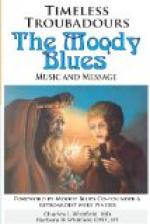Reference should here be made to a legendary institution which seems to have gripped the imagination of almost every tourist who writes a book of travels in Southern France, the so-called Courts of Love.[9] In modern times the famous Provencal scholar, Raynouard, attempted to demonstrate the existence of these institutions, relying upon the evidence of the Art d’Aimer by Andre le Chapelain, a work written in the thirteenth century and upon the statements of Nostradamus (Vies des plus celebres et anciens poetes provencaux, Lyons 1575). The latter writer, the younger brother of the famous prophet, was obviously well acquainted with Provencal literature and had access to sources of [20] information which are now lost to us. But instead of attempting to write history, he embellished the lives of the troubadours by drawing upon his own extremely fertile imagination when the actual facts seemed too dull or prosaic to arouse interest. He professed to have derived his information from a manuscript left by a learned monk, the Moine des Iles d’Or, of the monastery of St Honorat in the Ile de Lerins. The late M. Camille Chabaneau has shown that the story is a pure fiction, and that the monk’s pretended name was an anagram upon the name of a friend of Nostradamus.[10] Hence it is almost impossible to separate the truth from the fiction in this book and any statements made by Nostradamus must be received with the utmost caution. Andre le Chapelain seems to have had no intention to deceive, but his knowledge of Provencal society was entirely second-hand, and his statements concerning the Courts of Love are no more worthy of credence than those of Nostradamus. According to these two unreliable authorities, courts for the decision of lovers’ perplexities existed in Gascony, Provence, Avignon and elsewhere; the seat of justice was held by some famous lady, and the courts decided such questions as whether a lover could love two ladies at the same time, whether lovers or married couples were the more affectionate, whether love was compatible with avarice, and the like. [21]
A special poetical form which was popular among the troubadours may have given rise to the legend. This was the tenso,[11] in which one troubadour propounded a problem of love in an opening stanza and his opponent or interlocutor gave his view in a second stanza, which preserved the metre and rime-scheme of the first. The propounder then replied, and if, as generally, neither would give way, a proposal was made to send the problem to a troubadour-patron or to a lady for settlement, a proposal which came to be a regular formula for concluding the contest. Raynouard quotes the conclusion of a tenso given by Nostradamus in which one of the interlocutors says, “I shall overcome you if the court is loyal: I will send the tenso to Pierrefeu, where the fair lady holds her court of instruction.” The “court” here in question was a social and not a judicial court. Had any such institution as a judicial “court of love” ever been an integral part of Provencal custom, it is scarcely conceivable that we should be informed of its existence only by a few vague and scattered allusions in the large body of Provencal literature. For these reasons the theory that such an institution existed has been generally rejected by all scholars of repute.




